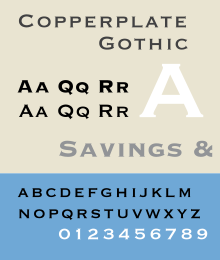This article includes a list ofgeneral references,butit lacks sufficient correspondinginline citations.(March 2012) |
Copperplate Gothicis atypefacedesigned byFrederic W. Goudyand first produced byAmerican Type Founders(ATF) beginning in 1901.
 | |
| Category | Wedge Serif |
|---|---|
| Designer(s) | Frederic W. Goudy |
| Foundry | American Type Founders |
| Date released | 1901 |
| Re-issuing foundries | Linotype |
While termed a "Gothic"(another term forsans-serif), the face has smallglyphicserifsthat act to emphasize the blunt terminus of vertical and horizontal strokes. The typeface shows an unusual combination of influences; the glyphs are reminiscent of stone carving or lettering oncopperplate engravings,the wide horizontal axis is typical ofVictoriandisplay types, yet the result is far cleaner and leaves a crisp impression inletterpressoroffset printing.
Goudy designed Copperplate Gothic in capitals only, since the design was intended to be used for headings and key words rather than for body text. It is not at all characteristic of Goudy's work, which is generally in the old-style serif genre. Goudy created it early in his career while in need of commissions, although he wrote in his 1946 autobiography that he "treasured" the drawings for their quality and noted that the design remained largely used.[1]It was developed on the initiative of ATF managerClarence Marderwhile Goudy was living inHingham, Massachusetts.ATF later cut other versions, such as bold styles, condensed and shaded styles, but never a lower case.
The typeface is often used in stationery, for social printing and business cards. It is also classically seenacid-etchedinto glass on the doors of law offices, banks and restaurants.
Master printer J. L. Frazier, no great fan of sans-serif types, wrote of it in 1925 that "a certain dignity of effect accompanies...due to the absence of anything in the way of frills," making it a popular choice for the stationery of professionals such as lawyers and doctors.[2][a]
Related typefaces
editThe general style of Copperplate Gothic is known as wedge-serif, due to the very narrow serifs pointing outwards, or as engraving faces due to the similarity with engraved letters. Copperplate Gothic's serifs, which are much less bold than the letters, are small by the standards of the genre. The wedge-serif style is sometimes called Latin, especially in Europe, and was quite popular there for much of the twentieth century. For example,Adrian Frutiger's early design Initiales Président (1952) was intended to be a French competitor; Frutiger in his autobiography noted that they were for makers of type "one of the safest investments. Smaller printers in particular had a steady demand for them."[3][4]His laterMéridien(also called Frutiger Serif) is a text face with some similarities, although this has more normal-sized serifs and a true lower-case.[5][6]
Notes
edit- ^Typifying his views, he wrote that 'It is worthy of note that Copperplate Gothic has the tiniest of serifs...sufficient to help its appearance materially. They seem to reduce somewhat the crudity of the letter. "
References
editCitations
edit- ^Goudy, Frederic (1946).A Half-Century of Type Design and Typography: 1895–1945, Volume 1.New York: The Typophiles. p.64.Retrieved18 November2015.
- ^Frazier, J.L. (1925).Type Lore.Chicago. p.20.Retrieved24 August2015.
{{cite book}}:CS1 maint: location missing publisher (link) - ^"President".Linotype.Retrieved12 September2015.
- ^Frutiger, Adrian (8 May 2014).Typefaces – the complete works.Walter de Gruyter. p. 27.ISBN9783038212607.
- ^"Adobe Méridien".MyFonts.Archived fromthe originalon 21 September 2015.Retrieved12 September2015.
- ^"Frutiger Serif".Linotype.Retrieved12 September2015.
Works cited
edit- Blackwell, Lewis.20th Century Type.Yale University Press: 2004.ISBN0-300-10073-6.
- Fiedl, Frederich, Nicholas Ott and Bernard Stein.Typography: An Encyclopedic Survey of Type Design and Techniques Through History.Black Dog & Leventhal: 1998.ISBN1-57912-023-7.
- Jaspert, W. Pincus, W. Turner Berry and A.F. Johnson.The Encyclopedia of Type Faces.Blandford Press Lts.: 1953, 1983.ISBN0-7137-1347-X.
- Macmillan, Neil.An A–Z of Type Designers.Yale University Press: 2006.ISBN0-300-11151-7.